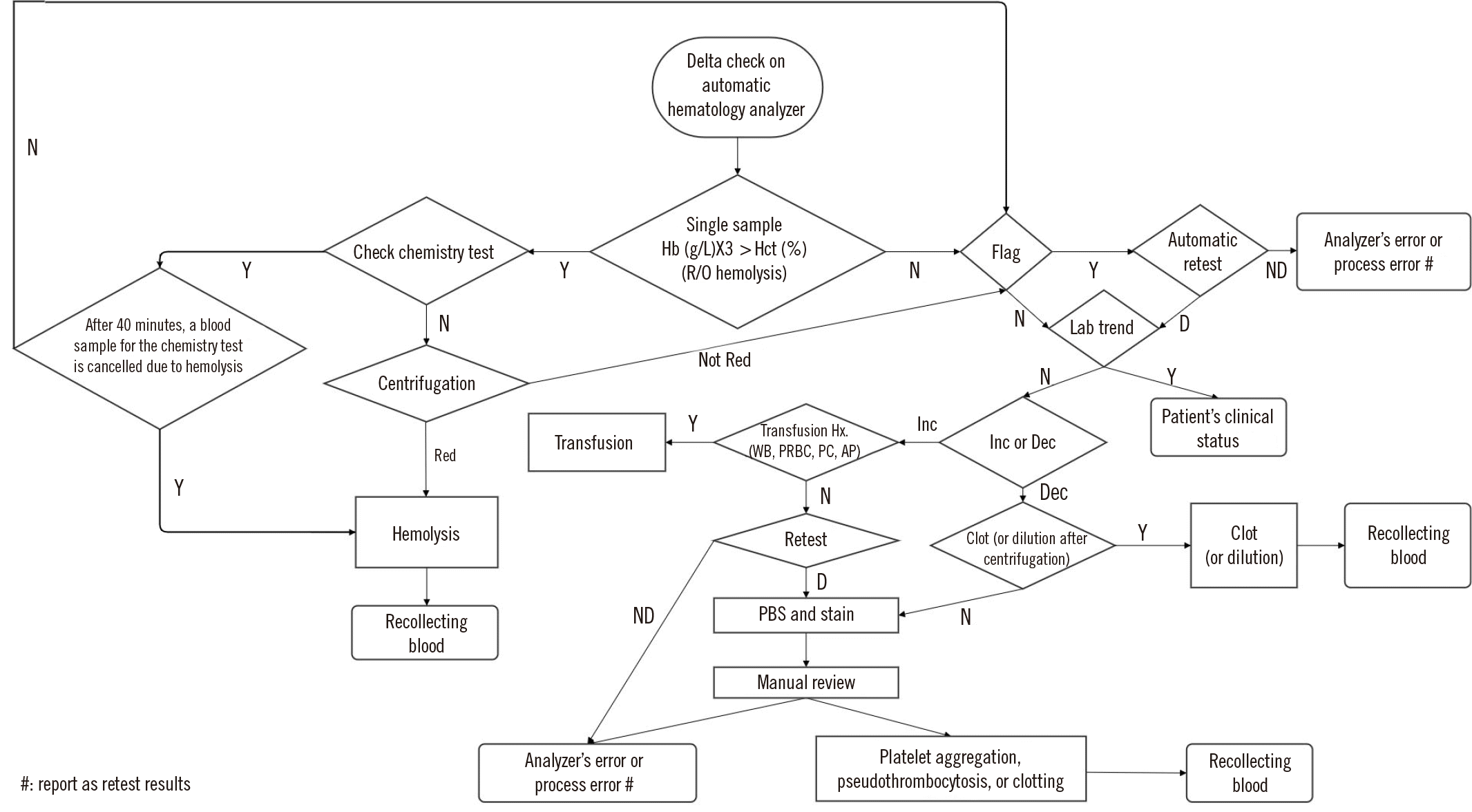1. Howanitz PJ. 1990; Quality assurance measurements in departments of pathology and laboratory medicine. Arch Pathol Lab Med. 114:1131–5.
2. Lindberg DA. 1967; Collection, evaluation, and transmission of hospital laboratory data. Methods Inf Med. 6:97–107. DOI:
10.1055/s-0038-1636364. PMID:
5611833.

3. Klee CG SP. Rowan RM, wan Assendelft OW, editors. Quality assurance for basic haematology count. Advanced laboratory methods in haematology. 1st ed. New York: Taylor & Francis;2001. p. 3–17.
4. Fraser CG, Harris EK. 1989; Generation and application of data on biological variation in clinical chemistry. Crit Rev Clin Lab Sci. 27:409–37. DOI:
10.3109/10408368909106595. PMID:
2679660.

5. Petersen PH, Fraser CG, Sandberg S, Goldschmidt H. 1999; The index of individuality is often a misinterpreted quantity characteristic. Clin Chem Lab Med. 37:655–61. DOI:
10.1515/CCLM.1999.102. PMID:
10475074.

6. Park SH, Kim SY, Lee W, Chun S, Min WK. 2012; New decision criteria for selecting delta check methods based on the ratio of the delta difference to the width of the reference range can be generally applicable for each clinical chemistry test item. Ann Lab Med. 32:345–54. DOI:
10.3343/alm.2012.32.5.345. PMID:
22950070. PMCID:
PMC3427822.

7. Lee J, Kim SY, Kwon HJ, Lee HK, Kim Y, Kim Y. 2016; Usefulness of biological variation in the establishment of delta check limits. Clin Chim Acta. 463:18–21. DOI:
10.1016/j.cca.2016.08.007. PMID:
27524506.

8. Hong J, Cho EJ, Kim HK, Lee W, Chun S, Min WK. 2020; Application and optimization of reference change values for delta checks in clinical laboratory. J Clin Lab Anal. 34:e23550. DOI:
10.1002/jcla.23550.

9. Kim JW, Kim JQ, Kim SI. 1990; Differential application of rate and delta check on selected clinical chemistry tests. J Korean Med Sci. 5:189–95. DOI:
10.3346/jkms.1990.5.4.189. PMID:
2100125. PMCID:
PMC3053796.

10. Schifman RB, Talbert M, Souers RJ. 2017; Delta check practices and outcomes: a Q-probes study involving 49 health care facilities and 6541 delta check alerts. Arch Pathol Lab Med. 141:813–23. DOI:
10.5858/arpa.2016-0161-CP. PMID:
28402169.

12. Tan RZ, Markus C, Loh TP. 2020; An approach to optimize delta checks in test panels - the effect of the number of rules included. Ann Clin Biochem. 57:215–22. DOI:
10.1177/0004563220904749. PMID:
31955587.

13. Ko DH, Park HI, Hyun J, Kim HS, Park MJ, Shin DH. 2017; Utility of reference change values for delta check limits. Am J Clin Pathol. 148:323–9. DOI:
10.1093/ajcp/aqx083. PMID:
28967949.

14. Rosenbaum MW, Baron JM. 2018; Using machine learning-based multianalyte delta checks to detect wrong blood in tube errors. Am J Clin Pathol. 150:555–66. DOI:
10.1093/ajcp/aqy085. PMID:
30169595.

15. Zhou R, Liang YF, Cheng HL, Wang W, Huang DW, Wang Z, et al. 2021; A highly accurate delta check method using deep learning for detection of sample mix-up in the clinical laboratory. Clin Chem Lab Med. 60:1984–92. DOI:
10.1515/cclm-2021-1171. PMID:
34963042.

16. Fu Y, Luo G, Tang Z, Li M, Chen S, Jiang H. 2020; Clinical validation of a delta check model in haematology automated counting improves data validation. Int J Lab Hematol. 42:77–81. DOI:
10.1111/ijlh.13143. PMID:
31830362.

17. Miller I. 2015; Development and evaluation of a logical delta check for identifying erroneous blood count results in a tertiary care hospital. Arch Pathol Lab Med. 139:1042–7. DOI:
10.5858/arpa.2014-0494-OA. PMID:
26230597.

18. Park HS, Kim JW, Kim JQ, Cho HI, Kim SI. 1989; Computerized processing of test results from Hematologic AutoAnalyzer. Korean J Clin Pathol. 9:49–58.
19. Yang YS, Kang HJ, Song UH, Joe HI, Kim SI. 1991; Experience with abnormal CBC histogram and delta and panic check. Lab Med Qual Assur. 13:201–4.
20. Koo BK, Ryu KH, Lim DJ, Cho YK, Kim HJ. 2012; Test turnaround time for complete blood cell count using delta and panic value checks and the Q-flag limit. Korean J Clin Lab Sci. 44:66–74.
21. Quintó L, Aponte JJ, Menéndez C, Sacarlal J, Aide P, Espasa M, et al. 2006; Relationship between haemoglobin and haematocrit in the definition of anaemia. Trop Med Int Health. 11:1295–302. DOI:
10.1111/j.1365-3156.2006.01679.x. PMID:
16903892.

22. Helms CC, Marvel M, Zhao W, Stahle M, Vest R, Kato GJ, et al. 2013; Mechanisms of hemolysis-associated platelet activation. J Thromb Haemost. 11:2148–54. DOI:
10.1111/jth.12422. PMID:
24119131. PMCID:
PMC3947421.

23. Gulati G, Uppal G, Gong J. 2022; Unreliable automated complete blood count results: causes, recognition, and resolution. Ann Lab Med. 42:515–30. DOI:
10.3343/alm.2022.42.5.515. PMID:
35470271. PMCID:
PMC9057813.

24. Lippi G, Plebani M, Simundic AM. 2010; Quality in laboratory diagnostics: from theory to practice. Biochem Med (Zagreb). 20:126–30. DOI:
10.11613/BM.2010.014.

27. He S, Kang F, Wang W, Chen B, Wang Z. 2020; National survey on delta checks in clinical laboratories in China. Clin Chem Lab Med. 58:569–76. DOI:
10.1515/cclm-2019-1131. PMID:
31927514.





 PDF
PDF Citation
Citation Print
Print




 XML Download
XML Download